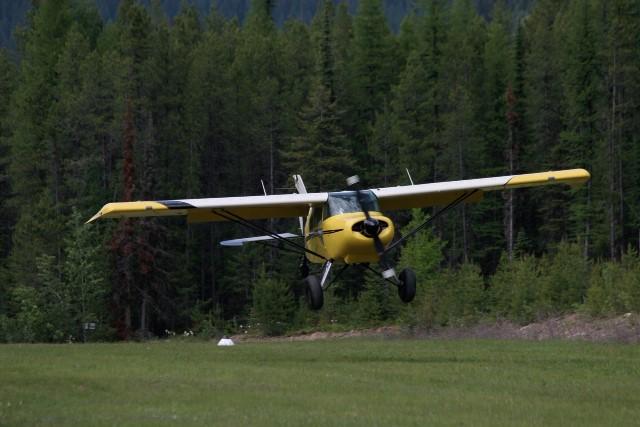RAF MISSION RESONATES WITH STOL PILOTS

Over ten yeas ago around a campfire in the backcountry of Montana, a few pilots voiced their concern about the closure of some of their favorite backcountry airfields. They formed the Recreational Aviation Foundation and its mission to preserve, maintain and create public-use recreational and backcoutnry airstrips nationwide has struck a chord from STOL pilots to those more comfortable in a retractable twin. Its membership now numbers over 6,000 folks.
On private land, the RAF has spearheaded efforts to include aviation in each state’s individual recreation use law, and at this time, 24 states now include aviation language. This has resulted in more private landowners being willing to open their airfields for public use, typically on a permission-first basis.
The RAF works hard to grow partnerships by being a credible, non-confrontational voice for backcountry aviation. “We can’t do this alone,” RAF president John McKenna often says. The RAF has made good friends along the way with AOPA, GAMA, and many grass-roots organizations like SuperCub.org, Seaplane Pilots Assoc., BackcountryPilots.org, and has gained hardworking cooperation from many state pilots’ organizations, whose members show up for volunteer work parties, often concluding in a steak barbecue after the pulaskis and loppers are set aside. The RAF has excellent relations with public land managers such as US Forest Service, Bureau of Land Management, National Park Service and the Bureau of Reclamation. “It surprises public land managers who get pressure from extreme environmentalists, that aviation is a very low-impact way to access the backcountry,” said RAF past vice president Dan Prill. “They appreciate that we advocate the ‘leave no trace’ approach to land use,” he added.
One success on public land was the creation of a new airstrip in Montana’s Lewis & Clark Nat’l Forest. The project came about because the Montana Pilots Assoc. partnered with RAF, working closely with the USFS.
The RAF is being gifted a recreational airstrip from landowners Ben and Agnes Ryan, adjacent to Glacier Nat’l Park – now open to public use, upon confirmed receipt of a current safety briefing. (Go to: http://theraf.org/ryan-field-safety-briefing) At 3,660 ft elevation and 2,500 ft long, STOL pilots will enjoy using their specialized techniques.
How does the RAF accomplish all this? It recruits energetic, dedicated state liaisons who reach out to their respective state pilots’ organizations, its Dep’t of Aeronautics and other groups to identify projects to preserve or create recreational aviation destinations.
In Arizona, for example, RAF Liaison Mark Spencer forged a successful partnership with the USFS, which resulted in reopening Double Circle Ranch airfield. After identifying it and its recreational potential, Mark and the Forest Service recreation officer coordinated a work party of local folks and pilots after which the USFS authorized reopening the airstrip.
In Florida, RAF Liaison Jack Tyler and RAF board member Tim Clifford teamed up with Florida’s Blackwater River State Forest District Manager to make improvements to the field. The RAF then hosted the first public aviation event in decades at Blackwater Airfield.
Both the Bureau of Land Management and the National Park Service have drafted their own Memorandum of Understanding with the RAF, outlining responsibilities for the preservation and maintenance of recreational airfields on their lands.
To the uninitiated, the idea of STOL flying may seem risky. But Spencer has discovered data that may surprise folks. Taking 2010 national statistics, there were 762 Off Highway Vehicle (OHV) fatalities. There were 30 takeoff and landing fatalities, resulting in a ratio of 24:1 OHV to aviation fatalities. Efforts like Mark’s further the RAF mission, to bring forth hard data illustrating the safety of access by air. The study states:
“Pilots are among the most highly trained operators; they are required by the FARs to pass regular medical exams by FAA certified doctors, pass biennial flight reviews by FAA certified instructors, and pass annual aircraft inspections by FAA certified mechanics.”
And STOL pilots are no exception. Objective reports like this are very important to the success of opening more destinations for recreational flying, as they illustrate the low exposure to landowners, both on private and public lands.
The RAF emphasizes safety and ethical use of the backcountry. RAF Safety and Education Coordinator, Master CFI Jeanne MacPherson of Helena, Montana writes, “STOL pilots agree their objective is enhanced flying safety and improved aircraft performance. In general, their STOL kit allows slower flight, reducing turning radius and reducing take-off and landing distance. In addition, there is usually greater effectiveness of the control surfaces during slow flight, which can improve aircraft control in challenging situations like cross-winds.”
She goes on to advise, “After adding a STOL kit, it’s critical for pilots to establish their ‘new numbers’, that is, their power settings and speeds both at minimum controllable airspeed and at the stall in all typical configurations and at the density altitudes usually flown. This is the first step in determining the aircraft’s new landing, take-off, and canyon cruising speeds.”
Because the RAF emphasizes good backcountry etiquette, she discourages practicing in the wilderness and instead asks pilots to practice at their home field. She emphasizes stabilized, power-on landings employing a steeper (roughly 4.5%) glide path. “Safety and accuracy demand precision and consistency in approach speeds, plus aim and touchdown points.”
Pilots place much emphasis on their landings, but she reminds us that take-offs are just as important. “One technique that provides a safe margin for trees and terrain on climb out is a smooth, rolling start in a tail-low near 3-point attitude. Let the plane fly itself off (do not force it off) and then reduce your angle of attack to fly in ground effect and accelerate to climb speed. Practice at or close to home, preferably on a grass strip. Once you can land where you want with no float; and you know your takeoff distance and climb capability, then you’re ready for the backcountry.”
THE RAF is also studying the effect of small aircraft noise on wildlife. DNA samples were gathered at Schafer, Meadow Creek, Ryan Field and Russian Flat in Montana; and Johnson Creek and Big Creek in Idaho. Funded in large part by AOPA Foundation and Montana Dep’t of Transportation, the study is intended to form a credible basis for productive discussion regarding aviation access to some of our nation’s special places.
Headquartered in Bozeman, Montana, the RAF is a non-profit public charity with 501 (c) 3 status. All donations are tax-deductible. Officers, directors, liaisons and committee persons are unpaid volunteers. See: www.theraf.org
Submitted on October 28, 2014.
